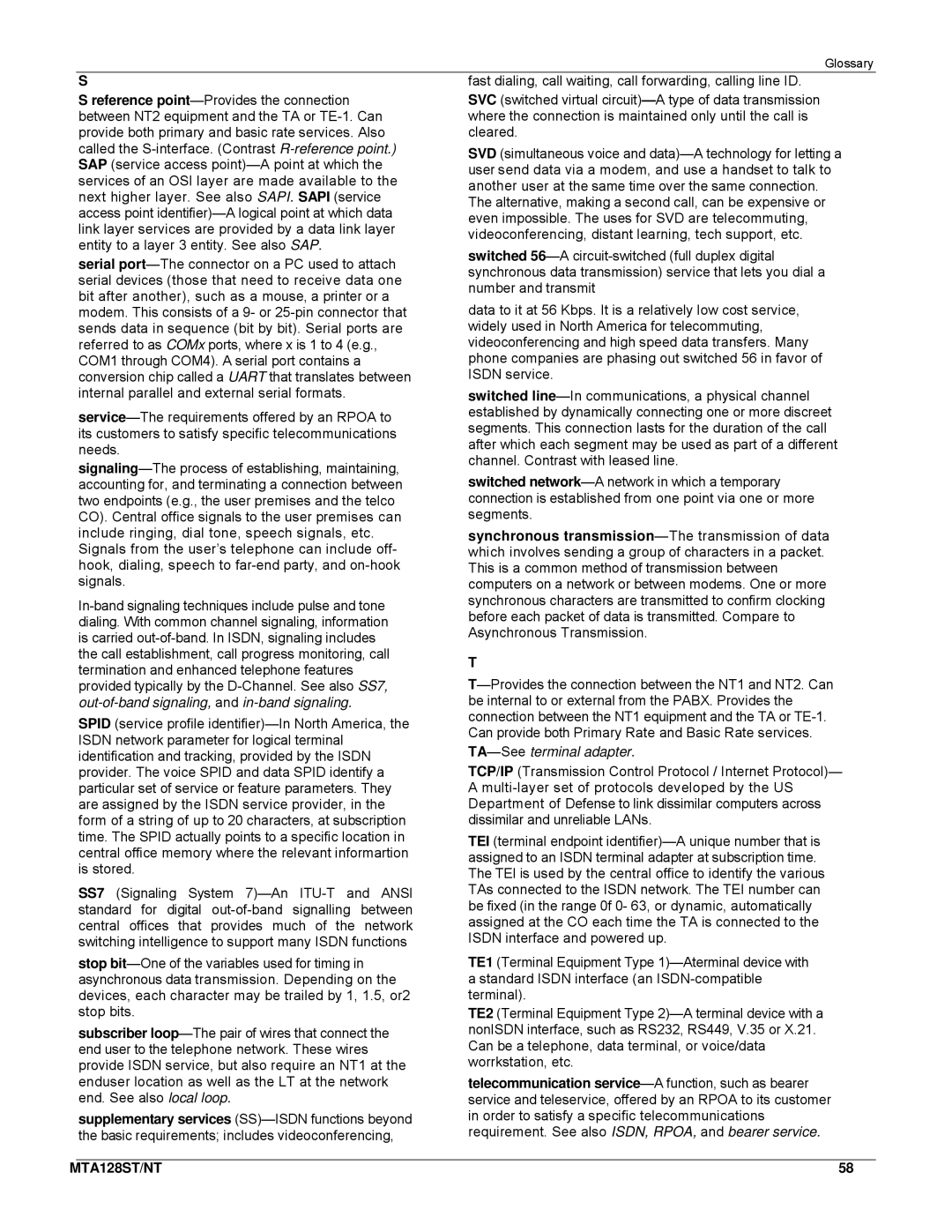S
S reference point—Provides the connection between NT2 equipment and the TA or TE-1. Can provide both primary and basic rate services. Also called the S-interface. (Contrast R-reference point.) SAP (service access point)—A point at which the services of an OSI layer are made available to the next higher layer. See also SAPI. SAPI (service access point identifier)—A logical point at which data link layer services are provided by a data link layer entity to a layer 3 entity. See also SAP.
serial port—The connector on a PC used to attach serial devices (those that need to receive data one bit after another), such as a mouse, a printer or a modem. This consists of a 9- or 25-pin connector that sends data in sequence (bit by bit). Serial ports are referred to as COMx ports, where x is 1 to 4 (e.g., COM1 through COM4). A serial port contains a conversion chip called a UART that translates between internal parallel and external serial formats.
service—The requirements offered by an RPOA to its customers to satisfy specific telecommunications needs.
signaling—The process of establishing, maintaining, accounting for, and terminating a connection between two endpoints (e.g., the user premises and the telco CO). Central office signals to the user premises can include ringing, dial tone, speech signals, etc.
Signals from the user’s telephone can include off- hook, dialing, speech to far-end party, and on-hook signals.
In-band signaling techniques include pulse and tone dialing. With common channel signaling, information is carried out-of-band. In ISDN, signaling includes the call establishment, call progress monitoring, call termination and enhanced telephone features provided typically by the D-Channel. See also SS7, out-of-band signaling, and in-band signaling.
SPID (service profile identifier)—In North America, the ISDN network parameter for logical terminal identification and tracking, provided by the ISDN provider. The voice SPID and data SPID identify a particular set of service or feature parameters. They are assigned by the ISDN service provider, in the form of a string of up to 20 characters, at subscription time. The SPID actually points to a specific location in central office memory where the relevant informartion is stored.
SS7 (Signaling System 7)—An ITU-T and ANSI standard for digital out-of-band signalling between central offices that provides much of the network switching intelligence to support many ISDN functions
stop bit—One of the variables used for timing in asynchronous data transmission. Depending on the devices, each character may be trailed by 1, 1.5, or2 stop bits.
subscriber loop—The pair of wires that connect the end user to the telephone network. These wires provide ISDN service, but also require an NT1 at the enduser location as well as the LT at the network end. See also local loop.
supplementary services (SS)—ISDN functions beyond the basic requirements; includes videoconferencing,
fast dialing, call waiting, call forwarding, calling line ID.
SVC (switched virtual circuit)—A type of data transmission where the connection is maintained only until the call is cleared.
SVD (simultaneous voice and data)—A technology for letting a user send data via a modem, and use a handset to talk to another user at the same time over the same connection. The alternative, making a second call, can be expensive or even impossible. The uses for SVD are telecommuting, videoconferencing, distant learning, tech support, etc.
switched 56—A circuit-switched (full duplex digital synchronous data transmission) service that lets you dial a number and transmit
data to it at 56 Kbps. It is a relatively low cost service, widely used in North America for telecommuting, videoconferencing and high speed data transfers. Many phone companies are phasing out switched 56 in favor of ISDN service.
switched line—In communications, a physical channel established by dynamically connecting one or more discreet segments. This connection lasts for the duration of the call after which each segment may be used as part of a different channel. Contrast with leased line.
switched network—A network in which a temporary connection is established from one point via one or more segments.
synchronous transmission—The transmission of data which involves sending a group of characters in a packet. This is a common method of transmission between computers on a network or between modems. One or more synchronous characters are transmitted to confirm clocking before each packet of data is transmitted. Compare to Asynchronous Transmission.
T
T—Provides the connection between the NT1 and NT2. Can be internal to or external from the PABX. Provides the connection between the NT1 equipment and the TA or TE-1. Can provide both Primary Rate and Basic Rate services.
TA—Seeterminal adapter.
TCP/IP (Transmission Control Protocol / Internet Protocol)— A multi-layer set of protocols developed by the US Department of Defense to link dissimilar computers across dissimilar and unreliable LANs.
TEI (terminal endpoint identifier)—A unique number that is assigned to an ISDN terminal adapter at subscription time. The TEI is used by the central office to identify the various TAs connected to the ISDN network. The TEI number can be fixed (in the range 0f 0- 63, or dynamic, automatically assigned at the CO each time the TA is connected to the ISDN interface and powered up.
TE1 (Terminal Equipment Type 1)—Aterminal device with a standard ISDN interface (an ISDN-compatible terminal).
TE2 (Terminal Equipment Type 2)—A terminal device with a nonISDN interface, such as RS232, RS449, V.35 or X.21. Can be a telephone, data terminal, or voice/data worrkstation, etc.
telecommunication service—A function, such as bearer service and teleservice, offered by an RPOA to its customer in order to satisfy a specific telecommunications requirement. See also ISDN, RPOA, and bearer service.
